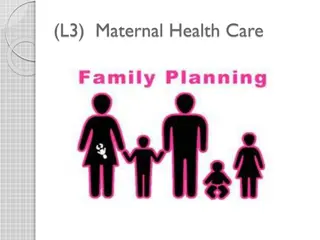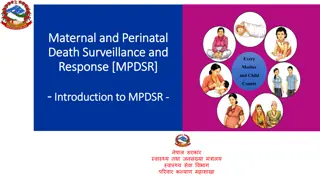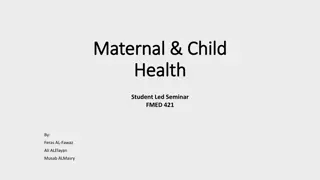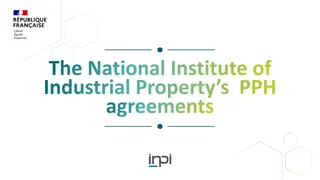Enhancing Maternal Health: AMPLI-PPHI's Efforts in PPH Prevention and Management
AMPLI-PPHI, led by Michael Muthamia, aims to reduce maternal mortality and morbidity by promoting the adoption of new PPH prevention and treatment drugs. The program focuses on heat-stable carbetocin, tranexamic acid, and misoprostol, aiming to overcome supply-side barriers and shape markets. Target countries include India, Kenya, and others, with a focus on improving procurement, supply chain, and sustainable financing for PPH interventions.
Download Presentation

Please find below an Image/Link to download the presentation.
The content on the website is provided AS IS for your information and personal use only. It may not be sold, licensed, or shared on other websites without obtaining consent from the author.If you encounter any issues during the download, it is possible that the publisher has removed the file from their server.
You are allowed to download the files provided on this website for personal or commercial use, subject to the condition that they are used lawfully. All files are the property of their respective owners.
The content on the website is provided AS IS for your information and personal use only. It may not be sold, licensed, or shared on other websites without obtaining consent from the author.
E N D
Presentation Transcript
PPH prevention and management: From Guidelines to practice Progress , Challenges & Solutions Presenter: Michael Muthamia AMPLI-PPHI Program Lead-Kenya
Driving Catalytic Change to Prevent & Treat Postpartum Hemorrhage (PPH) Accelerating Measurable Progress & Leveraging Investments for PPH Impact 2 Elaine Roman- JAM 2023
What will AMPLI-PPHI do? August 2022- July 2026 Contribute to reduced maternal mortality and morbidity by catalyzing early adoption and readiness for scale-upof new and recently recommended drugs to prevent or treat PPH Heat stable carbetocin (HSC) Prevention of PPH during active management of the third stage of labor in facilities Tranexamic Acid (TXA) Treatment of PPH together with uterotonics and IV fluids Misoprostol Advanced distribution for women delivering in their communities
AMPLI-PPHI:Positioning countries & shaping markets Evidence Generation Demonstration: feasibility, acceptability, cost effectiveness Enabling Environment Readiness for scale-up > Tool development, demand generation, advocacy, community engagement Market Readiness Overcoming supply-side barriers > Drug price, manufacturer diversity (HSC), low quality products
Countries: Propelling Learning & Catalytic Change Target & Influence Countries Target Countries Influence Countries Madagascar Congo-Brazzaville Cameroon Burkina Faso Benin Cote d Ivoire Mali Bangladesh Nepal India (5 additional states) Sri Lanka Tanzania Uganda South Africa DRC Guinea India Kenya
AMPLI-PPHI Target Country Actions (DRC, Guinea, India, Kenya) Procurement and Supply Chain Facilities & Community Providers Patient TXA Oxy, other Uterotonics Hospital & Health Center Provider HSC Drugs Introduced by Project HSC TXA Miso Sustainable Financing Facility Readiness TXA Procurement & Supply Chain Assessment & Recommendations Service Delivery Oxy, other Uterotonics TXA TXA Quality Improvement Health Post Provider HSC Equitable access to the right drugs, at the right place, at the right time to prevent and treat PPH and reduce maternal mortality Supply Security Provider Capacity Building & Mentorship HSC HSC HSC TXA Quality Assured Products Where IV injections are available Administration of Miso Miso Miso Community Community Health Worker Miso Miso Engagement with Manufacturers, Ministry of Health (MOHs), District Leaders, Facility Management, Health Providers, Community Leaders and CSOs Strategic Levers KEY Tranexamic Acid TXA Market Shaping Advocacy & Partnership Human-Centered Design Demand Generation Implementation Research Learning & Adapting Data Collection & Analysis Dissemination & Communication Policy & Regulation Heat Stable Carbetocin HSC Global Actions Misoprostol for advanced distribution for PPH prevention Miso Market Readiness Exchange Countries Evidence Generation WHO Guidelines
Key milestones and challenges Challenges Phase one Milestones Lack of local or real world evidence Delay in registration of medicines Parallel initiatives to introduce PPH Recs Misalignment updating policy documents 4. Update Health Information management system 1. Create awareness among decision makers Solutions 2. Update national guidelines 5. Update training materials and develop job aids 1. Generate evidence or utilize available evidence 2. Create synergy and collaborate 6. Develop a national roadmap and roll out plan 3. Update the Essential Medicines list 3. Advocate 4. WHO Collaborative Registration Process
Key milestones and challenges Challenges Limited awareness HCPs Women and families Phase two Milestones Delays in procurement Resistance to change by HCPs Limited resources 1. Create awareness among implementers 4. Train Healthcare providers Solutions 2. Determine health products and technologies requirements 5. Create awareness among communities 1. Generate, disseminate evidence and learnings 6. Introduce HPTs and monitor use 2. Create synergy and collaborate 3. Mobilize resources and procure 3. Advocate 4. Strengthen documentation and pharmacovilance
Amplifying our voices on PPH; collaborating with other advocates Project Staff Ministry of Health KOGS, Jhpiego, PATH Division of Reproductive and Maternal Health Department of Health in the County Governments 1 Professional Associations 6 2 Kenya Obstetrical and Gynaecological Society, Midwifery Association of Kenya, Pharmacetical Societyof Kenya, Kenya Pharmaceutical Association, National Nurses Association, Kenya Union of Clinical Officers, Kenya Society of Anaethesia, National Association Of Clinical Officer Anaesthetists Kenya Civil Society Organizations WACI Health, Reproductive Health Network, Anita Mbinya Foundation, White Ribbon Alliance among others 5 3 Implementing partners 4 Christian Health Association of Kenya,, Jacaranda Health, Afya Ugavi, InSupply, Clinton Health Association of Kenya , ThinkWell, AMREF, Lwala Community alliance among others Academia Management and teaching staff from Medical College representatives from universities and colleges
Creating awareness on PPH among Postpartum Women and Families Community Health Promoters Home visits Maternity Open Days Dialogue & action days Local Media Expert interviews PPH stories 7 Child Birth in hospital 1 6 IEC materials Posters Audio messages Animated videos Danger signs Opinion Leaders Chiefs Religious leaders Business people Community influencers PPH 2 5 Facility Health Education and Counseling Client Rights Individual Birth Plan Community Based Organizations Support and leverage ongoing community events Mother to Mother support groups Father to Father support groups 3 4 PPH ORIENTATION
Progress towards availability of HSC & TXA in the supply chain-Kenya TXA is available in supply chain Determine country needs through Quantification Inclusion in the National guidelines Registration of access price HSC Advocate for procurement of HSC by KEMSA and MEDS Create awareness in readiness for product arrival Advocate for purchase and safe use 555,385 Ampoules Est. requirement for FY23/24 360,000 Ampoules Intended purchase by KEMSA
Available Funding Mechanisms Eligibility Included the new and lesser- used PPH medicines into EML and/or guidelines. Funding ceiling maximum of USD$100,000 No limit to the applications. Eligibility Resources allocated based on need and strategic opportunities. Forecasting and quantification report























